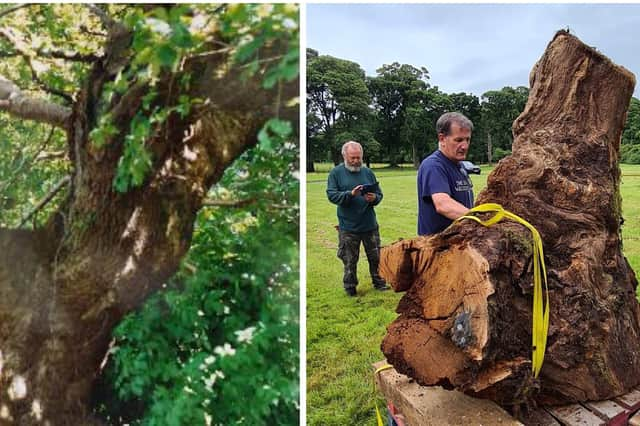Remains of oak to which Sir William Wallace said to have been chained to go on display


The Wallace Oak was a popular landmark in Port Glasgow, Inverclyde, where the medieval freedom fighter was held briefly following his capture in August 1305.
Known as "the tree where Wallace bled", the ancient oak toppled during a storm in 1992.
Advertisement
Hide AdAdvertisement
Hide AdA large section of the trunk, salvaged and kept in storage for 30 years, was given a permanent home in October at 15th century Hunterston Castle in North Ayrshire, home of Clan Hunter.
Members of the public can now book tickets to see the legendary object in its new home during a special event on May 21.
Neil Lochiel, of the Society of William Wallace, the charity that rescued the historic object, said: "The oral tradition over seven centuries tells us this was the tree to which Sir William Wallace was chained awaiting transfer from his captors to the English soldiers on 4th August 1305, before being taken to London on his final journey."
Wallace, who defeated an English army at the Battle of Stirling Bridge in 1297, was betrayed and captured at Robroyston on 3 August 1305.
Taken first to Dumbarton Castle, according to tradition the following morning he was transported by boat to West Ferry near modern day Langbank.
He is then said to have been chained to an oak tree in Port Glasgow before being transferred to English soldiers and taken down to Westminster Hall.
Wallace was hanged, drawn and quartered at Smithfield in London on 23 August 1305 as the opening spectacle of Bartholomew Fair, the largest medieval market in England.
The Port Glasgow oak has long been associated with Wallace.
For centuries, it was preserved when other trees around it were cut down, and its story was kept alive by people who would attach chains to it and paint them red.
Advertisement
Hide AdAdvertisement
Hide AdAfter the tree fell in 1992, the most complete section was kept in a scrapyard for over 20 years before campaigners sought a permanent home where Wallace's story could also be told.
The segments of tree were examined in March 2016 by tree specialist Dr Coralie Mills - one of just three dendrochronologists in Scotland who concluded “the tree could have been a decent size at the time of William Wallace’s capture in 1305”.
“Despite the dendrochronological age of the sampled part of the tree being late 18th century, the organism as a whole could have been much older,” he said at the time.
“We cannot refute the Wallace tradition on the basis of the dendro results.”
The preserved oak has been lifted onto a bespoke base in a ground floor vaulted room in Hunterston Castle, where it will be illuminated and kept at a constant temperature alongside an information board.
A large granite memorial was unveiled in 2021 on the spot where the famous tree stood, in the grounds of what is now the Holy Family Church.
Sculpted in the shape of a split trunk surrounded by a blood-red chain, it was partly funded through the sale of fragments of the wood.
Comments
Want to join the conversation? Please or to comment on this article.